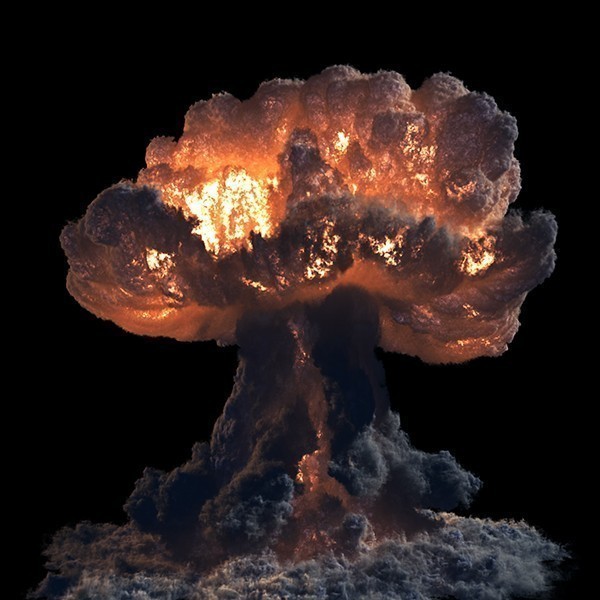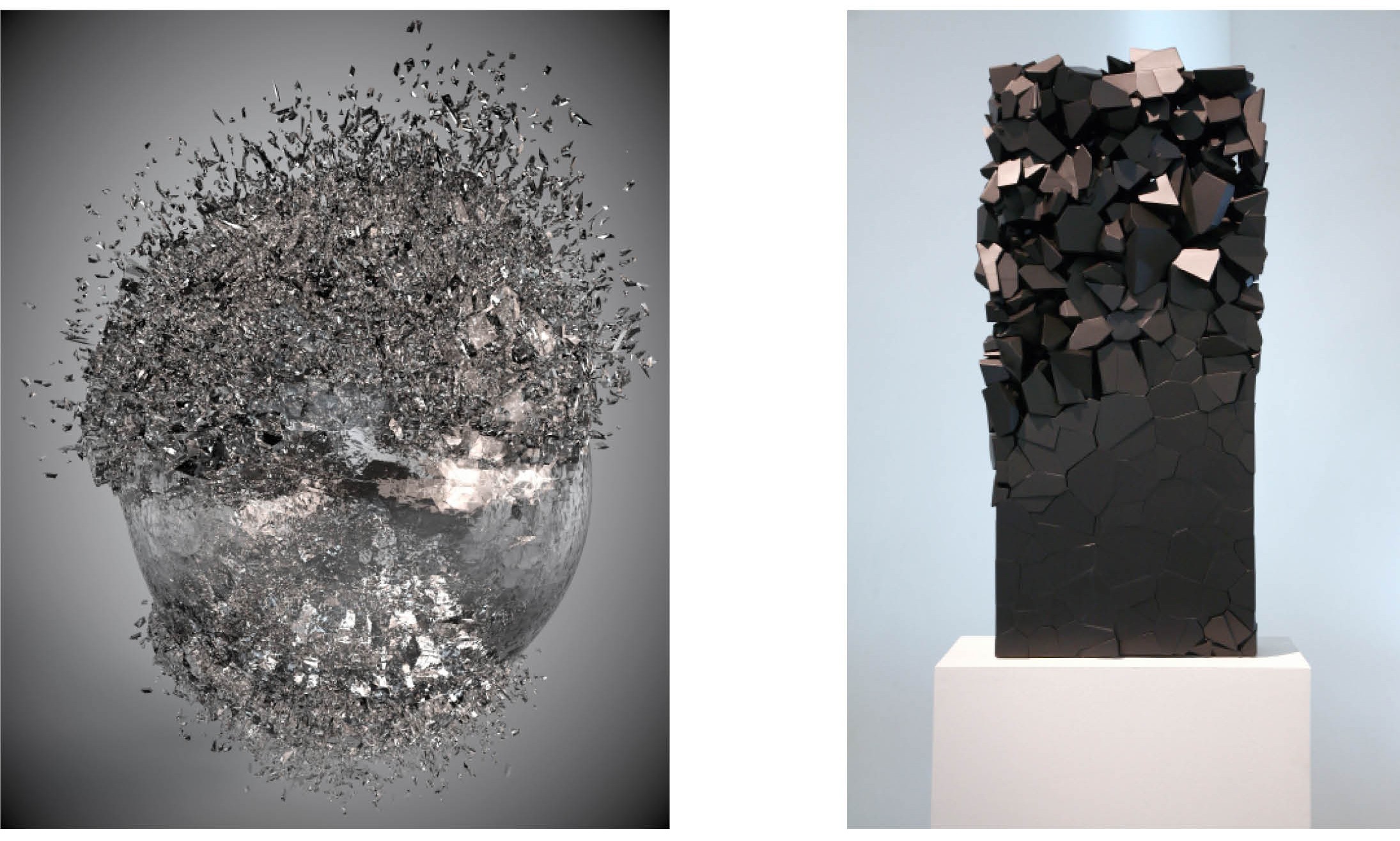
(L) Nuclear Bomb, 2012 © Eyal Gever
Influenced by the destructive forces in our environment, Israeli programmer and digital artist Eyal Gever creates sculptures based on moments that fill the viewer with awe, terror, astonishment, amazement, or silence. He is fascinated by cataclysmic extremes, uncontrollable power, and unpredictability: forces that serve as reminders of the constant fragility of human life. Using his own proprietary 3D animation software, Gever, who lives in Tel Aviv, has developed computational models for physical simulation, computer animation, and geometric modeling. His work—recreations of devastating scenarios, from oil spills to volcano eruptions—explores the intersection of destruction and beauty, and captures catastrophic situations as cathartic experiences.
In his work, Gever marries his two greatest passions: art and programming. He was introduced to the latter while serving in the Israel Defense Forces’ Central Computing System Unit in the early 1990s. Here he specialized in advanced programming applications and was tasked with crafting electronic simulations to calculate the effects of explosions, collisions, and other devastating events.
After completing his compulsory military service in 1992 and a stint at Israeli Educational Television, Gever spent two years at Jerusalem’s Betzalel Academy of Art and Design. While in college, he founded his own digital arts company, Zapa, a startup that let customers create their own avatars. The company was later renamed Gizmoz. Gever soon became a figurehead for the emerging Internet generation and was able to collaborate with the most influential people in the IT industry.
Mundane to Sublime
Throughout the nineties, Gever’s career went from strength to strength. Unfortunately, just when he was about to sell Zapa, in the spring of 2001, the dot.com bubble burst. And then came the September 11 attacks. Gever and his wife were living in New York City at the time.
“What struck me most—and I’ve tried to get this across in my art—is the intriguing interface between the mundane and the totally unexpected,” Gever said in an email. “So, for example, you’ll be in a totally normal setting, in my case on September 11, I was in the gym with my wife, Sharon, and something completely out of the ordinary happened.”
Gever was astounded by the terror and beauty he witnessed that day.
“I will never forget the epically terrible beauty of the deadly dust clouds roaring through downtown Manhattan,” Gever explained. “In the midst of an entirely innocent-seeming day, something entirely ‘other’ took place, and when it happened, I witnessed a sublime moment, a moment of beauty in the midst of a catastrophic event.”
Immediately after the attacks, Gever began to design a product more tangible than code. He decided to channel the skills he had learned in the army into his art.
Since then, Gever, together with an international group of programmers, mathematicians, and physicists, has been building mathematical models of man-made and natural disasters. Once they complete a model, Gever runs the results through the computer. In search of the sublime moment, he interrupts the model and transfers the image for 3D printing.

(L) Glass Blast Sphere, 2011/2012 (R) Wall Crash, 2012 © Eyal Gever
Beyond Fear
Gever is not interested in recreating a real disaster. Nor does he want to create memorials of real events. “I leave the connotations to the viewer,” Gever said. “I will show you crashes of rectangles that your brain will connote to things you’ve seen in the news, but for someone else it’s just shapes crashing.”
Gever relates his unique perspective on disasters to his outlook on life. He explained that he lives his life as if every day could be catastrophic, but he doesn’t let fear control him.
“I don’t know if it’s my army special operations/combat training experience or the fact that I grew up in a holocaust-traumatized small family of survivors,” Gever said. “But I accept the fact that every day can either be the day everything changes, or it can be my last day.”
Combining the horrifying and the beautiful is something that many artists before him have attempted, most notably the Vanitas painters who, during the early Renaissance created symbolic content meant to remind viewers of their relatively short life. In these paintings overtly macabre items such as human skulls were placed in juxtaposition to luxury items and other objects of fleeting beauty or pleasure. In a way, Gever’s art does the same—albeit in a less moralistic form. By freezing a devastating yet esthetically pleasing moment, he reminds us of the fragility of human life and illuminates the strength of the destructive forces in our environment.
Elke Weesjes Sabella is former editor of the Natural Hazards Observer. She joined the staff in December 2014 after a brief stint as a correspondent for a United Nations nonprofit. Under her leadership, the Observer was revamped to a more visual format and one that included national and international perspectives on threats facing the world. Weesjes was the editor of the peer-reviewed bimonthly publication United Academics Journal of Social Sciences from 2010 to 2013.
Weesjes Sabella also worked as a research associate for the Center for Disaster and Risk Analysis, formerly located at Colorado State University (although no longer active). In that role, she collected and analyzed data and translated research findings for a broader audience. She played a central role in finalizing the Disaster Preparedness among Childcare Providers in Colorado project, which examines all-hazards preparedness in daycares and in-home childcare across Colorado. She co-authored the report based on the first stage of the project, which was funded by Region VIII of the Federal Emergency Management Agency.
Weesjes Sabella specializes in cultural memory and neighborhood/community change in times of acute and chronic stress. She has published articles on the impact of drought on farming communities in Kansas, the effects of Superstorm Sandy in Far Rockaway, Queens, urban renewal in the Bedford-Stuyvesant neighborhood in Brooklyn, and health services for vulnerable populations in the South Bronx.
Weesjes Sabella received her PhD from the University of Sussex. Her dissertation, Children of the Red Flag: Growing up in a Communist Family During the Cold War (2012), as well as the majority of her publication record, share the common methodology of understanding culture and identity through oral history.